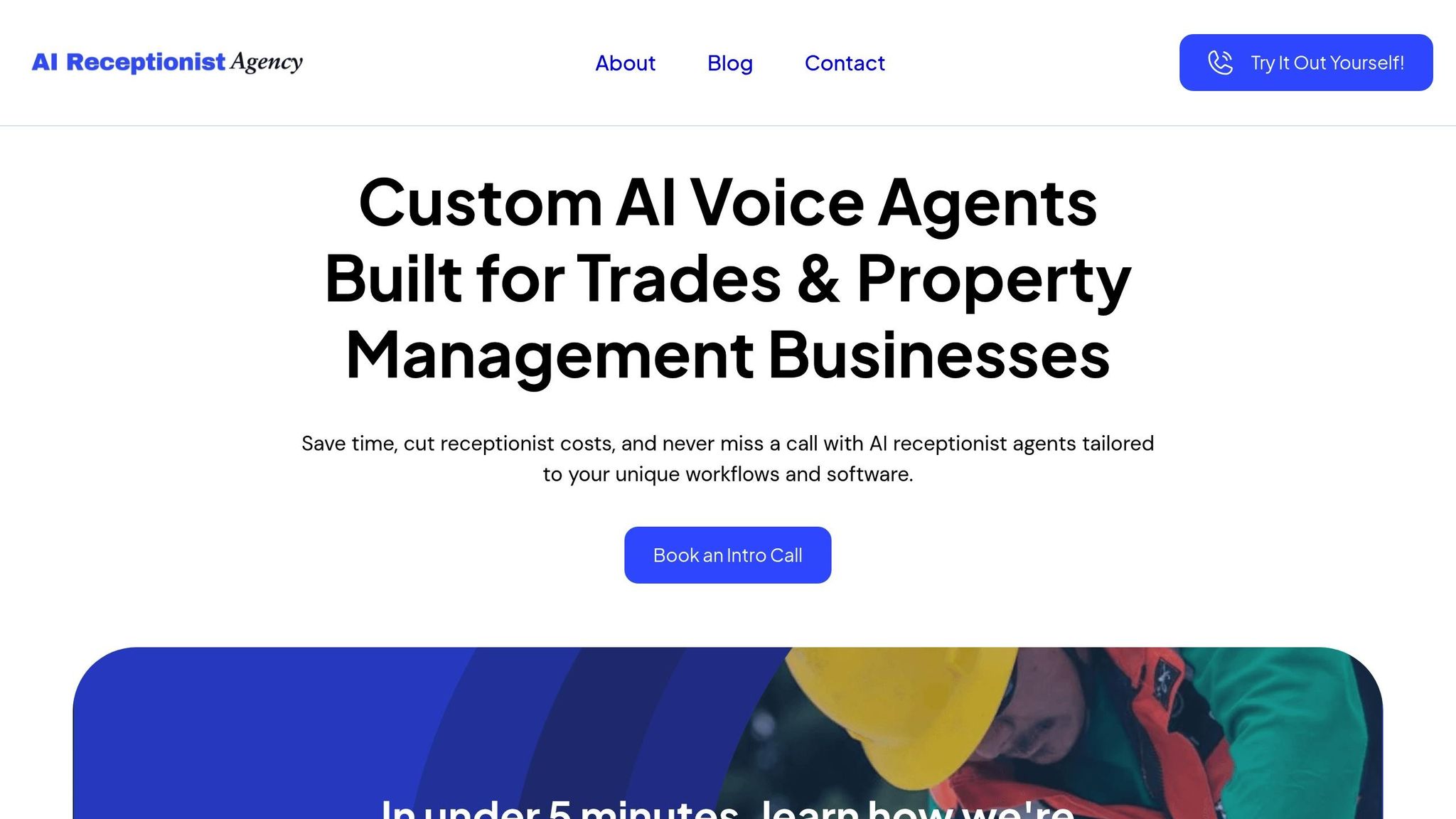
Businesses expanding internationally face one major challenge: language barriers. Multilingual AI offers a solution by enabling real-time, context-aware communication in multiple languages. Unlike basic translation tools, this technology understands tone and meaning, making interactions more effective.
Here’s why it matters:
From automating customer support to managing complex workflows, multilingual AI integrates with tools like CRMs, helping businesses save time, cut costs, and improve customer satisfaction. However, challenges like handling idiomatic expressions and technical integration remain, often requiring a mix of AI and human expertise.
For U.S. businesses aiming to grow globally, this technology isn’t just useful - it’s becoming essential for staying competitive.
Multilingual AI is reshaping how businesses handle global operations by automating interactions in multiple languages. These systems can detect and respond in a customer's preferred language, making tasks like appointment scheduling, lead qualification, and expanding international reach more efficient.
When a customer reaches out, AI systems powered by Natural Language Processing (NLP) and Machine Learning (ML) analyze both tone and context in real time. This goes far beyond basic translations. Large Language Models (LLMs) enable the AI to generate natural, context-aware responses in the customer's language, triggering workflows instantly and seamlessly.
Take this example: a Spanish-speaking customer wants to schedule an appointment. The AI detects the language, understands the request, checks availability, and confirms - all in Spanish. This kind of interaction feels effortless to the customer but is powered by sophisticated automation.
By integrating with enterprise tools like CRM platforms, scheduling systems, and knowledge bases, multilingual AI takes these capabilities even further. It can automatically create lead records, archive conversations, and save language preferences for future interactions. This level of integration ensures smoother workflows and personalized service.
Multilingual AI also simplifies more complex processes that usually require human involvement. It can handle routine queries, process service requests, and escalate complicated issues to human agents while maintaining both the context and the language of the interaction. For instance, if a German customer submits a technical support request, the AI can route it to a German-speaking specialist, complete with all the relevant details from the initial interaction. This seamless handoff improves efficiency and customer satisfaction.
The impact of multilingual AI is evident in real-world applications. For example, a leading SaaS company implemented multilingual voice automation across 15 markets, supporting English, Spanish, French, German, Japanese, and Mandarin. The system managed 50,000 interactions monthly with 94% accuracy, reducing costs by 60% and increasing customer satisfaction by 35%.
Businesses using multilingual AI typically see support costs drop by 50–70% while service quality and availability improve. These systems accelerate content updates by 40%, boost resolution rates by 30% across languages, and deliver a 215% return on investment within three years.
Speed is another key advantage. Leading platforms respond in under 500 milliseconds, ensuring real-time engagement. This quick responsiveness, paired with a nuanced understanding of cultural context, allows businesses to offer authentic and consistent service worldwide.
When issues require human intervention, the automation can escalate seamlessly. The system can initiate warm transfers or schedule callbacks, all while preserving the conversation history and language preferences. This ensures even complex problems are handled efficiently without sacrificing the personalized experience customers expect.

The AI Receptionist Agency uses multilingual AI to streamline global business operations, offering automation tailored to various industries. By combining advanced language processing with industry-specific features, the platform enables businesses to manage international workflows effortlessly.
This platform takes over complex multilingual workflows that used to require human oversight. Tasks like handling routine inquiries, scheduling appointments, and qualifying leads are managed across multiple languages with precision. Thanks to natural language processing (NLP), the system captures meaning and intent, ensuring customer queries are interpreted accurately.
For instance, imagine a Mandarin-speaking client reaching out to a legal firm for consultation. The AI identifies the language, qualifies the lead based on the client’s needs, schedules a meeting with the right attorney, and updates the CRM system - all while keeping the conversation context intact. This seamless integration ensures multilingual workflows are just as efficient as their monolingual counterparts.
Multilingual capabilities are a game-changer for businesses facing communication hurdles. Studies show that 75% of customers prefer to purchase products in their native language. By breaking language barriers, the platform helps businesses retain leads that might otherwise slip away. It even adapts to regional dialects and workplace-specific contexts, ensuring interactions are both accurate and culturally appropriate.
The AI Receptionist Agency customizes its multilingual tools to fit the unique needs of each industry.
Integrating these multilingual workflows delivers clear benefits for businesses. Companies report up to a 50% boost in lead conversion rates, a 60% reduction in overhead costs, and a 25–40% increase in customer satisfaction, thanks to faster responses and the elimination of language delays. Operational improvements are also significant, with businesses experiencing 30% higher project efficiency and 25% fewer delays when language barriers are addressed effectively. The platform's ability to integrate seamlessly with existing CRM systems and scheduling tools ensures these advantages are realized without disrupting current processes.
Multilingual AI workflows have proven to be efficient, offering clear advantages while also presenting some notable challenges.
On the financial side, businesses can significantly reduce translation costs - by as much as 90% - with AI-powered solutions. For example, one e-commerce company managed to cut its annual translation expenses by 85%, which allowed for faster localization in new markets.
From a customer experience perspective, the impact is undeniable. About 75% of consumers are more likely to repurchase when they receive support in their native language, and multilingual AI has been shown to boost retention rates by up to five times. This directly contributes to improved conversion metrics.
However, the road to implementation isn’t without obstacles. Technical challenges often arise, particularly with languages like German, which can require 20–30% more text than English, potentially disrupting user interface designs. Additionally, AI systems may struggle with idiomatic expressions and regional dialects, necessitating human oversight to ensure accuracy.
| Benefits | Drawbacks |
|---|---|
| 24/7 Global Coverage: AI can handle customer interactions in multiple languages around the clock, ensuring no international opportunities are missed. | Integration Complexity: Requires advanced technical infrastructure, including Unicode support and language-agnostic systems. |
| Cost Savings: Translation costs can be reduced by up to 90%, with significant cuts in operational overhead. | Cultural Nuances: AI often falls short in capturing subtle, context-specific language differences and regional dialects. |
| Compliance Features: AI solutions can meet standards like HIPAA for secure communication in medical and legal fields. | Quality Inconsistency: Performance varies depending on the language pair and content type, often requiring human intervention for technical or creative tasks. |
| Scalability: AI can handle unlimited simultaneous interactions in multiple languages without additional staffing. | Ongoing Maintenance: Regular updates are needed to keep up with evolving language trends and cultural expectations. |
A hybrid approach that combines AI efficiency with human expertise is often the best solution. Matt Rodano, VP of Account Management at Acclaro, emphasizes this balance:
"At Acclaro, we recognize the transformative potential of AI in localization, but we keenly understand its limitations. Our approach is to help our clients implement AI where it truly adds value and maintain human expertise to control accuracy, maintain brand voice, and deliver culturally nuanced content that their customers expect."
This blend of AI and human input forms the foundation of The AI Receptionist Agency’s strategy, allowing them to refine their multilingual automation and streamline global operations. By addressing common challenges through customized, industry-specific solutions and continuous learning, they provide a practical way to achieve smooth global communication.
For organizations looking to adopt multilingual AI, the advantages often outweigh the drawbacks - especially when supported by thoughtful planning and a hybrid model. This balance of benefits and challenges lays the groundwork for broader strategic considerations in global communication automation.
Multilingual AI is reshaping how businesses in the U.S. expand globally and streamline operations. It’s not just about simplifying workflows - it’s about driving growth on a strategic level. By integrating this technology, companies gain a competitive edge in international markets while trimming operational costs.
The financial impact is hard to ignore. AI-powered translation tools can slash translation costs by as much as 90%, leading to savings of 60–90% overall. For businesses aiming to scale internationally, these efficiencies could mean saving millions of dollars each year.
But the benefits go beyond just saving money. Multilingual AI enhances customer engagement and boosts operational performance. Companies using this technology report a 30% increase in project efficiency, a 25% reduction in delays, and improved customer loyalty thanks to native-language support.
The market trends back this up. By 2030, the global machine translation industry is projected to exceed $4 billion, a sharp rise from $1.1 billion in 2022. Additionally, 89% of Fortune 500 companies are already investing in AI to support their international growth strategies. This shows that early adoption isn’t just an advantage - it’s a necessity for staying ahead.
For U.S. businesses, seamless multilingual workflows mean significant efficiency gains. Companies like The AI Receptionist Agency offer tailored solutions, combining multilingual capabilities with industry-specific expertise. Their platform supports global reach through multi-language functionality and delivers personalized interactions with custom scripts and workflows. This approach ensures not only effective communication but also cultural accuracy and sensitivity.
As Vicky Teixeira, Global Content Specialist at Welocalize, aptly states:
"In a digital-first world, AI-driven localization isn't just an option - it's a competitive advantage".
The real question for U.S. businesses isn’t whether they should adopt multilingual AI - it’s how quickly they can implement it to seize the growing opportunities in global markets. Waiting could mean falling behind.
Multilingual AI does more than just swap words from one language to another. It uses sophisticated algorithms and an understanding of language nuances to capture tone, idiomatic expressions, and context. This ensures that communication feels authentic and resonates with the intended audience.
Unlike basic translation tools that often overlook subtle meanings or fail to account for regional sensitivities, multilingual AI adjusts seamlessly to different languages and cultural contexts. This makes it a powerful tool for businesses looking to engage diverse global audiences without compromising on precision or professionalism.
Bringing multilingual AI into a business’s existing operations isn’t without its hurdles. One of the biggest obstacles is ensuring that it works smoothly with legacy systems. Older systems may need updates or custom changes to accommodate AI-driven processes, which can be time-consuming and resource-intensive. On top of that, businesses must allocate time and resources to train their teams on how to effectively use and manage these AI tools.
Another significant challenge lies in maintaining the accuracy and relevance of translations. Multilingual AI needs to account for subtle differences in language, dialects, and cultural context to ensure communication remains clear and effective. Without proper configuration, testing, and continuous fine-tuning, businesses risk miscommunication that could harm user experiences.
That said, the effort pays off. Multilingual AI can help businesses expand globally, speed up customer support, and streamline operations. For companies looking to grow internationally, the potential rewards make tackling these challenges well worth it.
Multilingual AI simplifies global business operations by automating tasks that require language-specific expertise. These include areas like customer support, content translation, and cross-language communication. This automation can reduce reliance on large human teams, cutting costs by as much as 60% and boosting overall efficiency.
By helping businesses connect with diverse audiences more effectively, multilingual AI plays a big role in improving customer satisfaction and loyalty. This, in turn, can lead to increased revenue. Over time, companies leveraging this technology often see a noticeable return on investment, making it a valuable asset for businesses looking to expand internationally while keeping expenses under control.
Stay informed with our latest updates every week.
Our Blogs